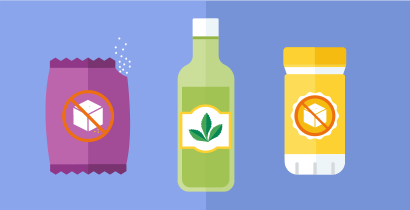Aspartame (Q&A): What is it and what foods contain this additive?
Last Updated : 31 July 2024Key takeaways:
- Aspartame is a low-calorie sweetener, about 200 times sweeter than sugar, with a similar taste.
- It is used in sugar-free or “light” products such as soft drinks, desserts, chewing gum, and table-top sweetener and should be listed on labels by name or E number (E-951).
- Aspartame breaks down in the gut into aspartic acid, phenylalanine, and methanol, all naturally present amino-acids in common foods, and it does not accumulate in the body.
- Regulatory authorities including EFSA, FDA, WHO, and JECFA confirm aspartame is safe for human consumption at current intake levels.
- In 2023, IARC classified aspartame as “possibly carcinogenic”, but evidence linking it to cancer in humans is limited and unconvincing.
Available for over 30 years, aspartame is approved for use in more than 100 countries around the world. Aspartame is a very thoroughly tested food additive with a comprehensive body of studies conducted in animal models and humans. All of these studies demonstrate that aspartame is safe.
The first European safety assessments of aspartame were published by the European Commission’s former Scientific Committee on Food (SCF) in 1984. Subsequent complementary assessments were made by the SCF in 1988, 1997 and 2002. Since the establishment of the European Food Safety Authority (EFSA) in 2002, the Authority reconfirmed the safety of aspartame in 2006, 2009, 2011 and most recently in 2013.1-4In 2023, the Joint Expert Committee on Food Additives (JECFA) of the United Nations Food & Agriculture Organization and the World Health Organization also reconfirmed that aspartame is safe to use in foods at the approved levels.5
What is aspartame and why is it used?
Aspartame is a low calorie sweetener. Aspartame provides 4 Calories per gram (similar to sugar) but because, weight for weight, it is approximately 200 times sweeter than sugar, very little aspartame is needed to sweeten foods. Aspartame therefore adds practically no calories to foods. Aspartame mimics well the taste of sugar, enhances citrus and other fruit flavours, and does not contribute to tooth decay.
In which products is it used?
Aspartame is used to replace sugar for the production of ‘energy-reduced’ food or food with ‘no added sugar’. It is also used in the production of food for particular nutritional uses. Examples of foods and beverages falling within these categories include sparkling soft drinks, desserts, sweets, dairy products, chewing gum, yogurt, low-calorie and weight control products, and as a table-top sweetener. The presence of aspartame must be indicated on the label either by its name its E number (E-951).
What happens to aspartame in the body once it is ingested?
Aspartame breaks down in the gut into its three constituent parts: two amino acids - aspartic acid and phenylalanine - and methanol, which are then absorbed into the blood. The two amino acids (aspartic acid and phenylalanine) are building blocks of protein and are found naturally in many everyday foods such as meat, fish, cheese, eggs and milk. Methanol is also found naturally in many foods, such as fruits and vegetables and their juices, and is part of the normal diet.
These components are used in the body in exactly the same ways as when they are derived, in much greater amounts, from common foods and beverage. For example, milk provides about 5 times more phenylalanine and 11 times more aspartic acid than a beverage sweetened with aspartame; tomato juice provides over 3 times the amount of methanol as an aspartame-sweetened beverage. Neither aspartame nor its components can accumulate in the body.
How can I tell if a product contains aspartame?
People can identify foods and drinks containing aspartame by looking at the ingredients list on the product label. Like all food additives approved for use in the European Union, aspartame has been assigned an "E-number". Its presence in foods is indicated either by its name (i.e. "aspartame") or by its number (E-951).6
Products containing aspartame should also state that it is a source of phenylalanine. This label is there to help people with a rare inherited genetic disorder called phenylketonuria (PKU). These people cannot metabolise phenylalanine from any source and need to control their intake of this amino acid.
How was aspartame approved in the European Union?
Aspartame was first authorised for use by individual Member States in the 1980s. European legislation harmonising the use of low calorie sweeteners in foodstuffs was introduced in 1994, following thorough independent safety evaluations by the European Commission Scientific Committee for Food (SCF) in 1984 and 1988. Further reviews of the data on aspartame were carried out in 1997 and 2002 by the SCF and these reconfirmed its safety.7
Today, the European Food Safety Authority (EFSA) is responsible for the work previously carried out by the SCF. Since the establishment of EFSA in 2002, the Authority reconfirmed the safety of aspartame in 2006, 2009 and 2011.1-3 The latest assessment of aspartame by EFSA was published on 10th December 2013.4 It forms part of its re-evaluation of all food additives which were authorised in the EU prior to 20 January 2009.
EFSA concluded that aspartame and its breakdown products in the body (phenylalanine, aspartic acid and methanol) are safe for human consumption at current intake levels and that the current Acceptable Daily Intake (ADI) of 40 milligrams per kilogram of body weight per day is suitable for the general population. According to the maximum permitted levels of aspartame in foods, flavoured drinks with aspartame (including soft drinks) can contain maximum 600 mg/L of aspartame (although they typically contain only between 100-350 mg/L). So, an average 70 kg adult person would have to drink at least 4.67 L (or approximately 14 cans of 330 ml) of soda per day to reach this ADI. Average real-life intakes of aspartame are well below the ADI, ranging between 0.7-8.5 mg/kg of body weight per day (in high consumers between 4.1-27.5 mg/kg of body weight per day).
In patients suffering from the medical condition phenylketonuria (PKU), the above ADI is not applicable, as they require strict adherence to a diet low in phenylalanine. With respect to pregnancy, EFSA noted that there was no risk to the developing foetus from exposure to phenylalanine derived from aspartame at the current ADI (with the exception of women suffering from PKU). EFSA also makes clear that the breakdown products of aspartame are also naturally present in other foods, for example methanol is found in fruit and vegetables. The contribution of breakdown products of aspartame to the overall diet is low.
Has the safety of aspartame been reviewed by other organisations?
The full body of science on aspartame has been reviewed by regulatory authorities around the world, including the US Food and Drug Administration (FDA) and in 2023 by the Joint Expert Committee on Food Additives (JECFA) of the United Nations Food & Agriculture Organization and the World Health Organization.5,8 In every case, aspartame was found to be safe.
In 2023, the International Agency for research on Cancer (IARC), an agency of the World Health Organization, reviewed all available studies related to cancer in humans and animal experiments on the sweetener aspartame.5 This led them to classify aspartame as “possible carcinogenic to humans” (a Group 2B carcinogen). However, this classification is based on limited evidence of carcinogenicity in humans and animals, and of limited mechanistic evidence on how carcinogenicity could occur, and it does not tell anything about the dose required, the route of exposure, or the increase in risk. In conclusion, the evidence of an association between aspartame consumption and cancer in humans is not convincing.
References
- European Food Safety Authority (EFSA). (2006). Opinion of the Scientific Panel on food additives, flavourings, processing aids and materials in contact with food (AFC) related to a new long‐term carcinogenicity study on aspartame. EFSA Journal, 4(5), 35
- European Food Safety Authority (EFSA). (2009). Updated opinion on a request from the European Commission related to the 2nd ERF carcinogenicity study on aspartame, taking into consideration study data submitted by the Ramazzini Foundation in February 20
- EFSA Panel on Food Additives and Nutrient Sources added to Food (ANS). (2011). Statement on two recent scientific articles on the safety of artificial sweeteners. EFSA Journal, 9(2), 1996.
- EFSA Panel on Food Additives and Nutrient Sources added to Food (ANS). (2013). Scientific Opinion on the re‐evaluation of aspartame (E 951) as a food additive. EFSA Journal, 11(12), 3496.
- International Agency for Research on Cancer. (2023) JOINT FAO/WHO EXPERT COMMITTEE ON FOOD ADDITIVES Ninety-sixth meeting (Safety evaluation of certain food additives). Retrieved from https://www.who.int/publications/m/item/ninety-sixth-meeting-joint-fao-w
- Regulation (EC) No 1333/2008 of the European Parliament and of the Council of 16 December 2008 establishing a common authorisation procedure for food additives, food enzymes and food flavourings
- [SCF] Scientific Committee on Food. (2002). Opinion of the Scientific Committee on Food: Update on the safety of aspartame.
- Food and Drug Administration. (2023). Aspartame and Other Sweeteners in Food. Retrieved from https://www.fda.gov/food/food-additives-petitions/aspartame-and-other-sweeteners-food (Accessed 10/01/2024)



